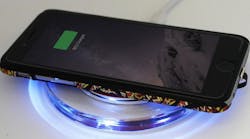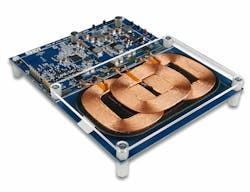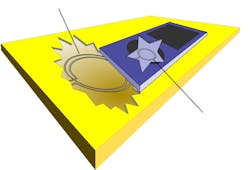No Need to Wait for the “Best” Wireless-Charging Solution—Qi Is It
Download this article in PDF format.
It took so long for wireless charging to gain momentum because three approaches were battling it out for supremacy: Qi from the Wireless Power Consortium (WPC), Powermat Airfuel from the Power Matters Alliance (PMA), and Rezence from the Alliance for Wireless Power (A4WP). Fortunately, the winnowing out is over, at least until longer-distance wireless charging is commercialized. The winner is Qi, but the others only called it quits just over a year ago when Apple finally chose its smartphones and Apple Watch. To their credit, the rivals circled their wagons twice before throwing in the towel.
Qi had an early lead—it was released in 2008 and Nokia, LG, and some other Android smartphone manufacturers chose it, followed by Toyota in the Avalon in 2013. Ikea even put Qi charging pads in some of their furniture. Now it’s everywhere, and as of last year, there were more than 160 different smartphones, tablets, and assorted other devices so endowed, as well as almost every other automaker.
Along the way, the looming presence of Qi caused PMA (Powermat) to merge with A4WP (Rezence) in 2015 to form the Airfuel Alliance, and the PMA continued its partnership with Starbucks and others to expand their footprint. However, when Apple made its belated decision, the PMA merged early in 2018 with the WPC and is now collaborating with the organization to bring some of its technology to Qi.
Current Powermat hardware now supports Qi with a software update, and all Starbucks locations and other places where Powermat is available. So, as there are now more than 360 companies supporting Qi and no other competitors, it’s game over.
Sponsored Resources:
- Turn-key Solution Fuels the Growth of In-Vehicle Wireless Charging Adoption
- Automotive 15W Wireless Charging Transmitter Reference Board
- P9221-R 15W Qi Wireless Power Receiver
Wireless Power Design Simplified
Qi’s ubiquity is good news for designers who need to integrate wireless power transfer into their devices as there’s no longer a choice to make. It has also given rise to a variety of solutions designed to make this remarkably easy. A good example is the Automotive Customer Reference Board (CRB) from Integrated Device Technology (IDT) that targets automotive applications (Fig. 1). It complies with the WPC extended power profiles up to 15 W and iOS and Android fast-charging modes.
1. The P9261-3C-CRB Automotive 15W Wireless Charging Transmitter Reference Board.
The board, based on the IDT P9261 AEC-Q100 chipset and MP-A13 3-coil transmitter, meets CISPR-25 EMI requirements. The reference design comes with a GUI that allows parameters to be fine-tuned including foreign object detection, protection limits, and timing. The AEC-Q100 chipset has current sensing, MOSFET drivers, and an M0 ARM processor. IDT also has a solution that combines 15-W power transfer with bidirectional communication capability.
But What About Those Points of Concern?
Like all new technologies, various web sites and other entities descended on Qi and wireless charging in general to verify all of the claims being made for it. And, as always, some issues were found. The obvious drawback is that the current state of wireless charging requires the “device to be charged” to remain on the charging pad or mat as the usable range is only about 1.6 in. It also must be positioned in the charger’s “sweet spot” where energy transfer is greatest, which isn’t that big a deal in practice.
The inductive coupling process also creates a lot of heat, which some researchers claim can reduce the operating life of a lithium-ion or lithium-polymer battery because these batteries perform better and last longer when their environment is controlled within a range of temperatures. However, the jury is still out on just how much this can degrade operating life, but it’s a factor—current phones cost as much as a decent laptop, will likely be kept longer by their owners, and battery replacement is expensive.
Another issue is efficiency, or the time it takes to fully charge a smartphone battery compared to a wired alternative. With inductive charging used by Qi, an electromagnetic field is generated in a coil in the charger that’s transferred to a conductive copper coil in the phone (Fig. 2). The captured energy is transferred to the phone’s battery-management system, which charges the battery. Some loss is incurred in this process, limiting its efficiency to about 40%. The amount of power transfer was originally low (5 W), but has now increased to 12 W in the latest Qi implementations.
2. The primary coil in the charger induces a current in the secondary coil in the device being charged. (Source: Wikipedia)
However, just as Qi was solidifying its presence, along came “fast” wired charging enabled within the USB 3.1 standard as implemented by a Qualcomm system-on-chip (SoC). Google immediately implemented the chip in its Pixel Series phones and now others as well in lieu of wireless charging (which is now available with the new Pixel 3). USB fast charging can transfer 100 W at 20 V dc over a USB C cable. In comparison, USB 3.0 can deliver up to 4.5 W, even less than a current Qi charger.
Now, while Google was the first to jump on fast USB charging, it just began offering the Pixel Stand. It combines 10 W of Qi power transfer while providing access to Google Assistant, acting as a “smart home” controller while keeping the phone in an upright position. There will no doubt be other interesting takes on this approach by others. So, the choice is now to stick with a much faster wired solution or more convenient, but longer, Qi charging.
In the long term, it’s reasonable to assume that wireless charging will put all or most of these concerns to rest because it’s still only about a decade old, and advances are coming. There’s certainly an incentive to make longer-range wireless charging possible, from charging airborne drones to medical and industrial equipment and even vehicles.
Extending the Charging Range
For example, researchers at North Carolina State University have demonstrated the ability to simultaneously transfer about 3 W of power and transmit data at rates (3.39 Mb/s) in a single wireless connection with separation of 6.3 in. The achievable distance between charger and device is slowly increasing as well with the current range being several feet. However, proprietary methods such as WattUp from Energous can reach up to 15 ft. using a remote charging transmitter and a tiny receiver embedded in the device, no pad or mat required.
In addition, several companies are taking wireless power transfer to an entirely new dimension that allows for much longer distances to be covered using a variety of techniques. For instance, resonant capacitive coupling developed by Solace Power can transfer up to 200 W up to 8 in. Another company, Wi-Charge, uses infrared beams to deliver up to 150 mW at a device 30 ft. away and 1 W up to 16 ft. The advantage in this case is that a single light source can be mounted in a ceiling (for example), covering a 250 ft.2 area and serving multiple devices.
All or some of these approaches are emerging, so it’s too soon to tell if they will produce the next generation of wireless power transfer. For now, Qi is now “the” solution used by nearly every manufacturer of consumer product, including vehicles, and the technology will no doubt advance to become even more efficient and transfer power over distances.
Sponsored Resources:


